The true armyworm, Pseuduletia unipuncta (Haworth), overwinters as a partly grown larva in Missouri. Resident armyworms are further supplemented by migrants that arrive during the first week of April. There are two to three generations each year in Missouri, but the larvae of the first generation in May and June usually cause the most feeding damage. This insect requires 41 to 66 days to complete a generation (egg to adult). Female moths prefer to lay their eggs in dense, grassy vegetation. True armyworm larvae have two characteristics that distinguish them from other armyworm larvae by:
- White-bordered, orange line down each side of the body.
- A large, single dark spot at the base of each fleshy, abdominal proleg (Figure 1a).
The yellowstriped armyworm, Spodoptera ornithogalli (Guenée), overwinters in the pupal stage in Missouri, and adults begin emerging in April and May. Generally, there are three to four generations per year in Missouri.
 Figure 1b
Figure 1b
Yellowstriped armyworm.
The yellowstriped armyworm requires approximately 40 days to complete a generation. Yellowstriped armyworm larvae can be distinguished from other armyworm species by:
- Paired, black, triangular spots along the back of each abdominal segment.
- A thin yellow line running lengthwise through each row of spots (Figure 1b).
The fall armyworm, S. frugiperda (Smith), does not overwinter in Missouri, but migrates northward from the Gulf Coast area. The first wave of migrants typically arrives in late June. Unlike true armyworm larvae, fall armyworm larvae also feed during the day and are particularly active in the early morning or late afternoon hours. This species generally requires 30 to 45 days to complete a generation.
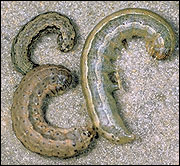
 Figure 1c
Figure 1c
Fall armyworm.
Fall armyworm larvae can be distinguished from true armyworm larvae by:
- The absence of black spots at the base of the abdominal prolegs.
- Four black spots on the eighth abdominal segment that form a square (Figure 1c).
- The presence of a pronounced inverted, white, Y-shaped mark on the head.
The beet armyworm, S. exigua (Hübner), is an exotic species that was brought into the United States from Asia. It is capable of overwintering (pupal stage) in Missouri, and the moths emerge in May. However, most infestations are the result of migrants from farther south. There can be two generations during each growing season. Once temperatures reach 80 degrees Fahrenheit, this insect can complete a generation in approximately 36 days. Beet armyworm larvae can be distinguished from other armyworm species by:
- Green to black coloration with a dark head
- Presence of a small, black spot on each side of the second abdominal segment behind the head (Figure 1d).
Damage
All four armyworm species only cause crop damage during their larval (caterpillar) stage. Each species feeds on the foliage of corn and other grass host plants; however, the beet, fall and yellowstriped armyworms also damage the foliage, squares, blooms and bolls of cotton.
 Figure 2
Figure 2
True armyworm foliar damage on corn.
Corn
True and fall armyworms are the primary armyworm pests on corn. True armyworms begin feeding on the lower leaves before moving to the top of the plant. Damage appears as irregular notching at the leaf margins. Young plants (less than 8 inches tall) can be completely defoliated, but older plants often retain the midrib of the leaf even during heavy infestations (Figure 2). Feeding damage most often occurs after cold, wet conditions in the spring slow the plant's growth and suppress the reproduction of the armyworm's natural enemies. Infestations also may be more severe in late-planted, no-till fields.
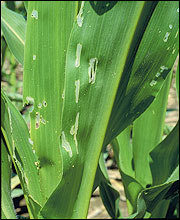 Figure 3
Figure 3
Fall armyworm foliar damage on corn.
Fall armyworm feeding damage typically begins with removal of the top leaf layer (Figure 3). As the larvae grow, they eat through the leaf, creating pin-sized holes. When the damaged leaves unfurl, they have a ragged appearance. Fall armyworms also damage corn by:
- Feeding on developing tassels
- Damaging immature ears
- Boring into stalks
 Figure 4
Figure 4
Beet armyworm foliar damage on cotton.
Cotton
Yellowstriped armyworms are primarily an early-season pest that can destroy young plants, but they also can damage squares and bolls later in the season. Beet armyworm larvae initially feed on leaves (Figure 4), and damaged plants typically have a ragged appearance. Later, larvae may feed on squares, blooms and bolls.
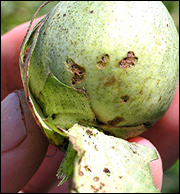 Figure 5
Figure 5
Fall armyworm damage on a cotton boll.
Fall armyworm larvae may feed on squares and blooms, but their principal damage is to the bolls (Figure 5).
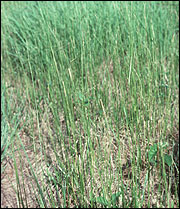 Figure 6
Figure 6
Damage caused by true armyworm in grass pastures.
Grass pastures
The true armyworm is attracted to the lush new growth of grass crops. Once the tender growth is consumed (Figure 6), the larvae may eat the rest of the plant or move on to find more succulent host plants.
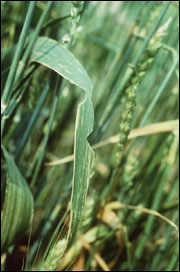 Figure 7a
Figure 7a
True armyworm foliar damage on wheat.
Wheat
In some years true armyworm larvae only feed on the leaves (Figure 7a), whereas in other years they also may cut the awns and seed heads (Figure 7b). True armyworm larvae are most destructive to wheat and other small grain crops when wet weather causes lush growth and lodging in the field.
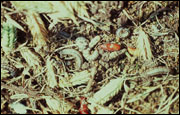 Figure 7b
Figure 7b
True armyworm seedhead damage on wheat.
Scouting
Corn
Producers should scout for true armyworm infestations when plants first emerge and continue scouting until plants develop several leaves. Armyworm larvae are generally inactive during the day; therefore, fields should be scouted during the early morning or late afternoon hours. Since late-planted and late-maturing corn is most attractive to fall armyworms, producers should begin scouting these fields in early June.
To determine whether your field has an economic infestation (action threshold to trigger insecticide spraying) of armyworms, randomly examine 20 plants at each of five locations per field. Take notes on the location of infestations in the field, larval size, and where the larvae are feeding on the plant.

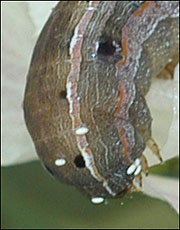
Figures 8a and 8b
Parasitized yellowstriped armyworm larva.
Also, observe the presence or absence of predators and diseased or parasitized (Figures 8a and 8b) larvae. If larvae are not visible but some feedingdamage is evident, carefully unroll and inspect the whorl of damaged plants for the larvae.
Cotton
When scouting fields for beet and fall armyworms, watch for egg masses by carefully examining both sides of the leaf. Beet armyworm egg masses are often deposited on the underside of midcanopy leaves and are about the same diameter as a pencil eraser. Female moths favor egg-laying sites in open-canopied fields, field edges, near gaps in plant stands, or on stressed plants. Initial beet armyworm feeding damage can be detected by looking for small, brown spots on the upper leaf surface. These spots are the result of the beet armyworms feeding on the lower leaf surface. Beet armyworm larvae frequently hide within rolled leaves to gain further protection from their natural enemies.
Fall armyworm larvae typically feed on large squares and bolls. When young larvae attack large fruit, the initial damage is etching on the inner surface of the boll bracts. This results in the characteristic "window pane" damage. They are often found in greater numbers in drought-stressed portions of the field. They also tend to occur farther down in the plant canopy and in the blooms. Fall armyworms generally spend more time feeding on individual fruiting forms than other caterpillar pests, such as cotton bollworms.
Grass pastures
True armyworm egg masses are typically laid in the thickest vegetation.
Wheat
Rank or dense fields of grasses or wheat are the most common infestation sites for true armyworm larvae. Scouting for true armyworms is best done late in the evening or during early morning hours because the larvae are primarily nocturnal feeders. They usually remain hidden on bright, sunny days. Producers should beginning scouting their wheat fields for this pest from mid April until harvest. Take note of larval sizes, percent parasitism and the insect's pepperlike droppings on the ground.
Economic threshold
Corn
For the true armyworm, treatment is recommended when 25 percent or more of the seedling corn plants are damaged and larvae are still present. Control of fall armyworm larvae is recommended when 75 percent or more plants are infested and larvae are less than l.25 inches in length. Insecticide applications to control larger larvae or those within the ears are not effective. In general, it is not economical to treat for fall armyworms unless infestations are severe and plants are stressed by environmental factors. Precaution: Before you select and apply an insecticide, review the manufacturer's label for information on the proper and safe use of the material.
Cotton, conventional
Insecticide treatment for beet armyworm infestations is recommended when five or more "hits" (egg masses or larval clusters) per 300 row-feet are found before Aug. 15. The threshold doubles to 10 or more hits after that date. Target applications at larvae less than .25 inch in length to obtain effective control of beet armyworm infestations. Treatment for the fall armyworm is recommended when more than four larvae per 100 blooms and bolls are present and before larvae start boring into the bolls. Insecticide applications are no longer effective once the larvae are inside the bolls. Target applications at egg masses and newly hatched larvae to obtain maximum control of fall armyworm infestations. There is no threshold for yellowstriped armyworms on cotton.
Grass pastures
Insecticide treatments are justified when four or more nonparasitized, half-grown or larger larvae are present per square foot.
Wheat
Insecticide treatments are warranted when an average of four or more nonparasitized, half-grown or larger true armyworm larvae per square foot are present during late spring and before two to three percent of the heads are cut from the plants. Parasitic flies commonly attack true armyworm larvae, and the flies' small, oval, yellowish eggs are laid on the larva's body or behind its head. The probability of yield loss increases when larvae destroy the flag leaf and before the plants complete the soft dough stage. Insecticides should be applied late in the afternoon to maximize larval exposure.
Management strategies
Corn
For both true and fall armyworms, good grass control within and along field margins helps reduce the risk of infestations. Good grass control reduces the number of alternative hosts for the larvae to feed and develop on, and it decreases the attractiveness of these fields to egg-laying moths. For the fall armyworm, early planting is the most effective cultural practice to minimize feeding damage.
Cotton
Maintain beneficial populations that help suppress armyworm infestations in the field by limiting the number of early-season insecticide applications. Cotton should be managed for an early "cutout" (maturity) to shorten the window when armyworm larvae can damage the crop.
If an insecticide application becomes necessary, thorough canopy coverage, timely applications, and targeting small larvae will increase the effectiveness of any rescue treatment. Consider planting second-generation Bt varieties in high-risk fields (i.e., fields near corn or those with a history of heavy weed pressure) to further reduce the risk of damage by armyworm species.
Good weed management (controlling pigweed, in particular) within and around cotton fields will help reduce the risk of fall and beet armyworm infestations.
Grass pastures
Various diseases, insect parasites and predators, and birds usually control true armyworm populations; however, the effectiveness of these natural control agents may be curtailed following cool, wet springs.
Wheat
Conserve beneficial arthropod populations that help suppress true armyworm infestations. Avoid management practices (e.g., excessive fertilization) that delay the crop's maturity and increase the attractiveness of the crop to egg-laying, female moths.
Armyworm larvae characteristics
Table 1
Comparison of armyworm larvae (caterpillars) feeding on field and forage crops in Missouri.
Beet armyworm
- Body color
Yellow to black with small black spot above second thoracic leg and behind the head - Head color
Dark - Length of larvae
1.25 inches - Stripe(s)
Single, wide - Eggs (number per mass)
Eggs (>50) initially white turning pink and covered with grayish moth scales - Feeding damage
Cotton - foliage (skeletonized), fruit - Feeding cycle
18-20 days - Crops attacked (examples)
Alfalfa, corn, cotton, vegetables (e.g., pea, tomato) - Weed hosts
cocklebur, pigweed
Fall armyworm
- Body color
Gray or brown with black bumps - Head color
Dark brown to black with inverted, white "Y" mark - Length of larvae
1.5 inches - Stripe(s)
Triple, wide - Eggs (number per mass)
Eggs (50 to several 100) and covered with grayish scales - Feeding damage
Corn - "window pane" foliar damage to large holes in leaves
Cotton - bolls - Feeding cycle
14-21 days - Crops attacked (examples)
Corn, grain, sorghum, cotton - Weed hosts
bermudagrass
Yellowstriped armyworm
- Body color
Pale gray to black with paired triangular spots along the top of each abdominal segment - Head color
Brownish with inverted, pale-yellow "Y" mark. - Length of larvae
1.75 inches - Stripe(s)
Double, lateral, yellow-orange - Eggs (number per mass)
Eggs (>50) initially green turning pink or brown and covered with grayish scales - Feeding damage
Corn - "window-pane" foliar damage, later stalk damage
Cotton-seeding foliage, bolls - Feeding cycle
Approximately 21 days - Crops attacked (examples)
Corn, cotton, vegetables (e.g., watermelon) - Weed hosts
jimsonweed, morningglory
True armyworm
- Body color
Dull green to brown with a large dark spot above each abdominal proleg - Head color
Tan to green-brown with dark, brown spots - Length of larvae
1.5 inches - Stripe(s)
Double, white-bordered orange line - Eggs (number per mass)
Eggs (>50) greenish white and covered with grayish scales - Feeding damage
Corn - seedling leaves destroyed and leaves of larger plants with only the midrib remaining
Wheat - seed heads - Feeding cycle
21-28 days - Crops attacked (examples)
Corn, grain sorghum, grass pastures, wheat - Weed hosts
crabgrass, fall panicum
 Figure 1a
Figure 1a